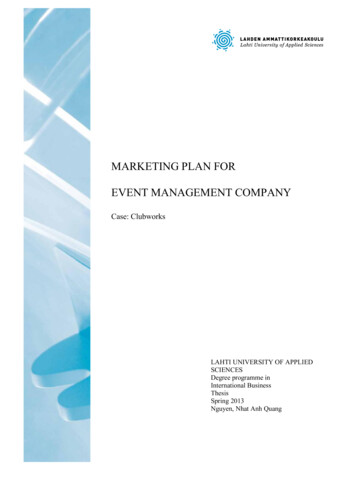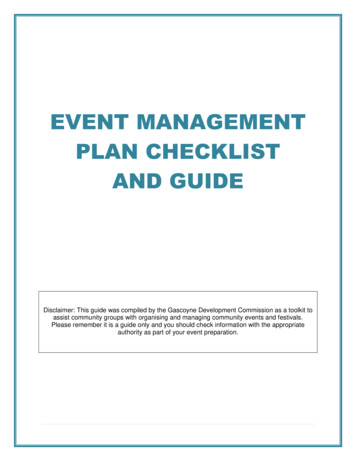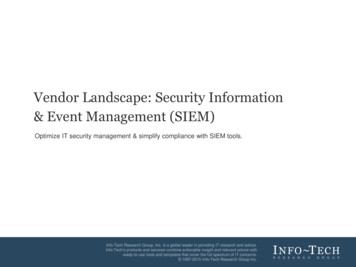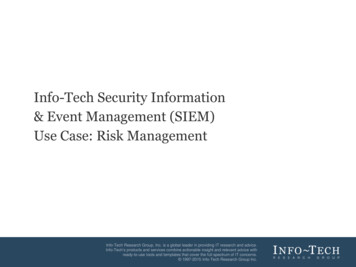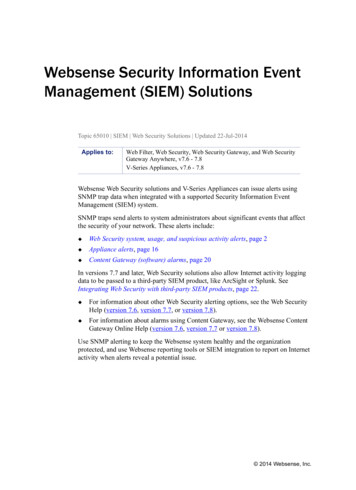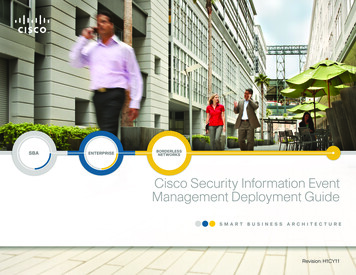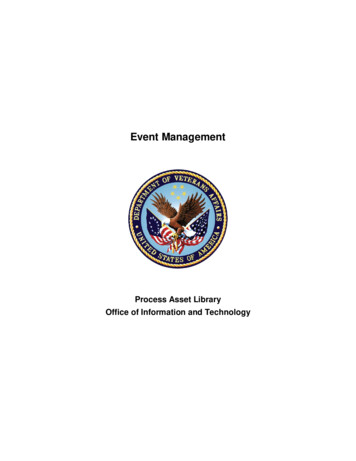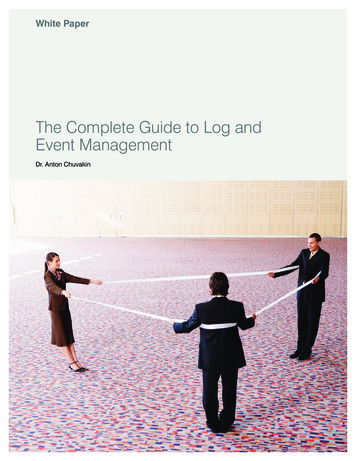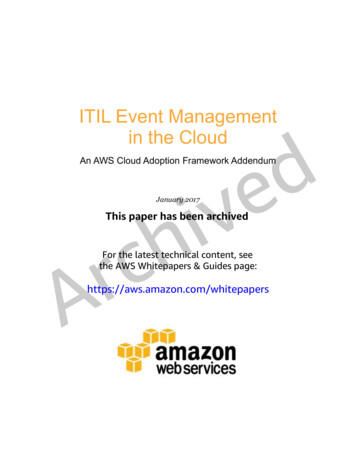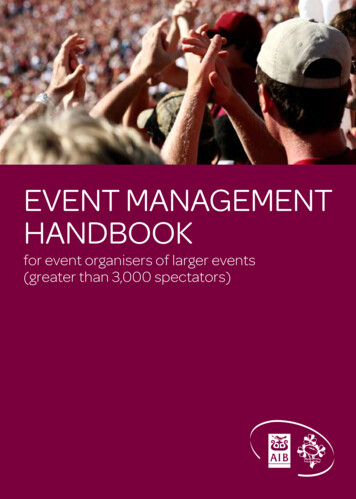
Transcription
EVENT MANAGEMENTHANDBOOKfor event organisers of larger events(greater than 3,000 spectators)
DisclaimerThe contents of this handbook are subject to periodic review in light of best practice, Government requirementsand regulations. No reader should act on the basis of any such information contained therein without referringto applicable laws and regulations and/or without seeking appropriate professional advice. Although every efforthas been made to ensure accuracy, the Irish Rugby Football Union shall not be held responsible for loss or damagecaused by errors, omissions, misprints or misinterpretation of the contents hereof. Furthermore, the Irish RugbyFootball Union expressly disclaims all and any liability to any person in respect of anything done, or omitted, by anysuch person in reliance on the contents of this handbook.September 2008, Version 12
ContentsPurpose4Scope5Advance planning6Pre-event planningManaging the riskRisk assessmentContractors and suppliers89911Providing a safe venueVenue designProviding space for peopleIngress and egressSigns, way-marking and circulationEvent control facilitiesStructural safetyTemporary covered accommodationBarriers/fencesLightingElectrical systemsFire prevention equipmentEnvironmental issuesNoiseCatering/food safetyOccasional food premises and permitsSanitary facilitiesDrinking waterLitter and wasteManaging vehicular trafficManaging ent staffManagement structureEvent controllerSafety officerChief stewardMedical managerAdditional event staffCommunicationsPublic informationMethods of communicationManaging communicationsPublic paring for the unexpectedMinor incident/issueMajor incidentAlerting the statutory services30303031DocumentationThe written plan3233External stakeholdersAn Garda Síochána/PSNILocal authorityFire authoritiesPlanningBuilding controlEnvironmental healthHealth authority - HSEPost event343434343535353636AppendicesAppendix 1:A: Licences and permissionsB: Hazards associated with temporarystructuresC: Event Management plan templateAppendix 2: Food safetyAppendix 3: Fire safety checklistAppendix 4: Sources of information3940414243FiguresFigure 1: Event phasesFigure 2: Steps of a risk assessmentFigure 3: Event management structureFigure 4: Event management planning cycle892533TablesTable 1: Feasibility issuesTable 2: Risk categoriesTable 3: Hazard assessmentTable 4: Communication failuresTable 5: Effective communications61010292937373
PurposeEvents are a workplace for some and a leisure activity for others and range from family days in the local park tomusical event festivals, firework displays, carnivals, sporting events etc. Negligence on the part of the owner ofthe premises and/or the organiser of the event can result in injury to either workers or patrons.The IRFU and individual clubs run and organise a multitude of different events throughout a year. These eventsinclude international/provincial/club games at all levels, festivals of rugby (tag, sevens, mini, veterans).This booklet is designed to provide advice to organisers of events who have under ‘common law’ a ‘duty of care’towards persons involved with an event, including players, patrons, suppliers and event staff. It outlines the stepsto be taken and the measures that can be implemented to provide for a safe event.4
ScopeThough venues and events may differ, theapplication of certain common principles andstandards of good practice can reduce theuncertainty associated with planning and organisingfor a safe and successful event. This bookletadvocates a common sense approach to eventorganisation by focusing on:123456Planning the eventProviding a safe venueStaff organisationPreparing for the unexpectedDocumentationEvent stakeholdersIn addition to the common law ‘duty of care’ owed tothose attending the event there are a number of keypieces of legislation, which are applicable to events.The most relevant include: Safety, Health & Welfare at Work Act 2005and regulations made under it (where there isemployment paid or unpaid) Planning and Development Act 2001: Part XVI(licensing of outdoor events regulations) Fire Services Act 1981 (responsibility for firesafety on persons in control of premises) Fire Services Act 1981 and 2003 (licensing ofindoor events regulations)Safety, health and welfare at work act 2006and regulations made there under is to ensure thesafety, health and welfare of all employees in theworkplace. The legislation applies to employers,employees and contractors. Even though the Actdoes not specifically mention the employment ofpersons at events it can be assumed that the taskwhich each individual undertakes, whether paid orunpaid is at the direction of the event organiser.The planning and development act 2001: Part XVI(licensing of outdoor events regulations) is specificto outdoor displays of public entertainmentcomprising an audience of 5000 or more.Organisers of such large-scale events should notplace reliance on the advice themselves but befamiliar with the relevant codes of practice, inparticular the Code of Practice for Safety at OutdoorPop Concerts and Other Musical Events(Dept. of Education - 1996)The fire services act 1981covers all aspects of fire safety and is applicableto both outdoor and enclosed venues. Eventorganisers have a responsibility to ensure thatthere are adequate means of escape for all personsin attendance. Particular attention should bepaid to materials used in the decoration of thevenue and the construction and use of temporarystructures to ensure they are in compliance withfire safety standards.Licensing of indoor events act 2003is an addition to the Fire Services Act 1981 andis intended to ensure the safety of personsattending events taking place wholly or mainly ina building. Unlike the licensing of outdoor eventsregulations, the licence application for an indoorevent is not restricted to an event with an expectedattendance of more than 5000. In addition theregulations provide for the licensing of events on anannual basis. In respect of all of the above it is theresponsibility of the event organiser to ensure theyare in compliance with the terms and conditions ofthe regulations and relevant legislation.5
Advance planningCommence planning well in advance of the proposed event opening date. How far in advance will be dependent onthe size, type and duration of the proposed activity and the logistics required for the event. Before committing tofinancial outlay you should first address the feasibility of organising the event at the planned date and venue. Some ofthe issues and considerations to be addressed at this feasibility stage include:IssueConsiderationDetails of other competingevents, which may take placeat the same timeThe timing of your event and the target audience could be affected by anotherevent organised at the same time and in the same area. Some local researchshould be undertaken before committing to the proposed date.Sponsorship opportunitiesCompanies or individuals may be interested in becoming associated with your event.It is your responsibility to ensure that your sponsor’s expectations can be met.A marketing strategyIf you want the public to attend your event you may have to develop amarketing strategy. This may range from flyers in your local area to radio andtelevision advertising.InsuranceNo event can take place without insurance; the availability of cover required willbe dependent on the activities, size and scale of your event and your efforts tominimise risk factors.Available fundsAn estimate of income and expenditure should be prepared as there are manycosts, which may not be apparent until you begin the detailed planning of yourevent. Items such as the collection and disposal of litter and waste can be anitem of expenditure that is sometimes forgotten when preparing your budget.Suitable venue availabilityThere may be an existing facility available for your event or you may need tomodify a facility. This is one of the most important factors when researchingthe feasibility of your project, some of the questions you should ask include: Will you need to construct temporary facilities? Is there sufficient space for the expected audience? Are there security considerations? Is there adequate access and egress from the site? Is there sufficient parking and/or loading areas nearby?Contact with relevant bodiesand agenciesAny activity, which involves a concentration of people gathering in one place,will have an effect on local infrastructure and it is common courtesy toinform agencies such as An Garda Síochána, and local residents of yourintention to hold an event. You may be obliged to enter into a formal consultative process with thestatutory agencies.Availability of resourcesResources required for events, include time, people, equipment and finance.Some of the questions you should address include: How many staff will the event require? Will some of the staff be paid? Is there sufficient time to plan the event? Is the equipment required available for the period of the event? Are there local sources of equipment? How much planning is required? What are the financial implications? Do I need professional assistance?Table 1: Feasibility issues6
InsuranceInsurance is one of the most important factors inorganising an event. The law requires the organiserto have Employers Liability cover for all employeesincluding unpaid helpers and Public Liability cover foryour patrons. The specific needs of your event shouldbe discussed with an insurance company or broker toensure that adequate cover is provided for the event.Venue owners may also request specific insurances andindemnities and in some cases the insurance companymay also require you to accept excess on the policy.7
Pre-event planningPlan for the organisation of your event in phases; details within each phase will be dependent on the event venue,scale, duration and planned activities. Any event will involve elements of each phase and you should identify thoseissues, which are relevant to your event and plan accordingly.PHASE 1Build-up and Load-inPHASE 2OperationsPHASE 3Load-out and BreakdownVenue DesignSelection of competent staffContractors and subcontractorsConstruction of structuresSafe delivery and installationof equipment and servicesManagement Strategies for:Crowds, Transport, Welfare,First Aid, Contingencies, Fire,Major Incident etc.Safe removal ofequipment and servicesRemoval of structuresRubbish and waste removalRemedial worksDebriefFigure 1: Event phasesIn all phases the establishment of a safety culture in management and operational practices is essential. Safety shouldnot be seen in terms of rules and conditions imposed from outside, but as a goal to which all parties to the event arefully committed. Regardless of the nature of the event general planning questions to be addressed include: Which organisations and groups of people need to be involved or kept informed?Are tickets required? How, where and when will tickets be sold?How many people are likely to attend? What are the capacity limits?What kind of audience will it be?How will they behave? What will their mood be?Have similar events taken place, which may give useful pointers to problems and solutions?How long will the event last?What facilities will need to be provided?What are the required staffing levels for different types of personnel?What different arrangements may be needed:- In the build up to the event?- During the course of the event?- During the wind-up phase?A wide range of venues can be used for events; in all cases it is good practice to ask the following questions: 8How will people get there? What planning issues are involved?What arrangements are needed for managing people outside the venue?What will be necessary for managing people inside the venue?How will they view the activities? Sitting? Standing? Festival Seating, circulating from one activity to another?What are the safe capacities? For the venue as a whole? For different sections?Is the venue already authorised to run a particular kind of event?
Managing the riskEvery event has attendant risks; the first step inmanaging those risks involves examining all areasof your event to determine where losses can occur.This examination is not limited to safety issues, butcan ensure that the event is conducted in the safestpossible manner and if something unfortunate doesoccur that the loss does not further impact theorganisation either financially or through adversepublicity. There are four general areas of lossesassociated with events: PersonnelPropertyIncomeLiabilityBy examining all areas where losses could possiblyoccur, you can identify where you may need topurchase additional insurance.Although the process may not guarantee that you haveidentified every possible risk factor associated withthe event, the exercise will assist with demonstratingyour diligence in attempting to identify those you canmanage and control and could be a factor in reducingyour obligatory insurance costs.For events the combination of individual risk factorsis extremely important in establishing the degree ofrisk. Changing one aspect of an event may greatlyincrease the risk factors. Some examples include: if freeadmission is allowed as a last minute decision that willchange the whole nature of risk for the event. If the eventis transferred from one location to another with lesscapacity you may have a serious problem of not beingable to seat everyone. If the weather suddenly changesyou may have risks for which you are not prepared.Risk assessmentIn compliance with health and safety law there is a legal requirement to undertake a risk assessment of those hazards,which could cause harm to your staff and/or members of the public attending the event. A risk assessment is asystematic approach to the control of hazards and should be done in relation to
scale, duration and planned activities. Any event will involve elements of each phase and you should identify those issues, which are relevant to your event and plan accordingly. In all phases the establishment of a safety culture in management and operational practices is essential. Safety should

